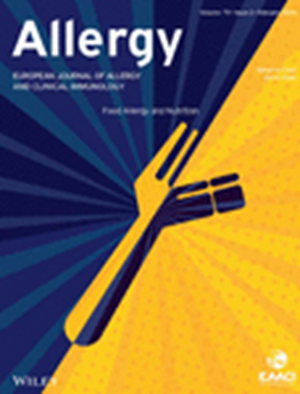斯普托巴特治疗中重度特应性皮炎的长期疗效和安全性:3 期试验的 52 周结果
IF 12.6
1区 医学
Q1 ALLERGY
引用次数: 0
摘要
背景中重度特应性皮炎(AD)的治疗需要长期治疗。Stapokibart是一种针对白细胞介素-4受体α亚基(IL-4Rα)的人源化单克隆抗体,IL-4和IL-13是AD的主要致病因素。在一项关键的 3 期试验(NCT05265923)中,接受斯普托巴特治疗的成人 AD 患者在第 16 周时,湿疹面积和严重程度指数(EASI-75;66.9% 对 25.8%)和研究者总体评估(IGA)0/1 分比基线改善≥75%,且减少≥2 分(44.2% 对 16.1%)的比例显著高于安慰剂。在此,我们报告该试验中 stapokibart 的长期(52 周)疗效和安全性。方法16 周双盲治疗结束后,stapokibart 组和安慰剂组患者进入 36 周维持治疗期,每 2 周接受 stapokibart 300 毫克治疗。结果 在进入维持治疗期的 476 名患者中,430 人完成了治疗。在第52周,分别有92.5%和88.7%继续服用斯普奇巴特的患者达到了EASI-75;分别有67.3%和64.2%的患者达到了IGA评分0分或1分且降低≥2分;分别有67.3%和60.5%的患者达到了瘙痒数字评定量表(PP-NRS)周平均值降低≥4分。在为期52周的治疗期间,88.1%的患者报告了治疗突发不良事件,其中大部分为轻度或中度不良事件。结论在中重度AD成人患者中,斯普托巴特的长期治疗显示出持续的疗效和良好的安全性。本文章由计算机程序翻译,如有差异,请以英文原文为准。
Long‐term efficacy and safety of stapokibart for moderate‐to‐severe atopic dermatitis: 52‐week results from a phase 3 trial
BackgroundManagement of moderate‐to‐severe atopic dermatitis (AD) needs long‐term therapy. Stapokibart is a humanized monoclonal antibody targeting interleukin‐4 receptor α subunit (IL‐4Rα), a shared receptor for IL‐4 and IL‐13 which are key pathogenic drivers of AD. In a pivotal phase 3 trial (NCT05265923), significant higher proportions of adult AD patients receiving stapokibart than placebo achieved ≥75% improvement from baseline in Eczema Area and Severity Index (EASI‐75; 66.9% vs. 25.8%) and Investigator's Global Assessment (IGA) score of 0/1 with ≥2‐point reduction (44.2% vs. 16.1%) at Week 16. Herein, we report long‐term (52 weeks) efficacy and safety of stapokibart from this trial.MethodsAfter 16‐week double‐blind treatment completed, patients in both stapokibart and placebo groups entered a 36‐week maintenance treatment period and received stapokibart 300 mg every 2 weeks. Concomitant use of topical medications for AD was permitted throughout the maintenance period.ResultsOf 476 patients entering maintenance period, 430 completed the treatment. At Week 52, EASI‐75 was achieved in 92.5% of patients continuing stapokibart and 88.7% of those switching from placebo to stapokibart, respectively; an IGA score of 0 or 1 with a ≥2‐point reduction was achieved in 67.3% and 64.2% of patients, respectively; a ≥4‐point reduction in weekly average of daily Peak Pruritus Numerical Rating Scale (PP‐NRS) was achieved in 67.3% and 60.5% of patients, respectively. Over the 52‐week treatment period, 88.1% of patients reported treatment‐emergent adverse events, most were mild or moderate.ConclusionLong‐term treatment with stapokibart demonstrated a sustained efficacy and favorable safety profile in adults with moderate‐to‐severe AD.
求助全文
通过发布文献求助,成功后即可免费获取论文全文。
去求助
来源期刊

Allergy
医学-过敏
CiteScore
26.10
自引率
9.70%
发文量
393
审稿时长
2 months
期刊介绍:
Allergy is an international and multidisciplinary journal that aims to advance, impact, and communicate all aspects of the discipline of Allergy/Immunology. It publishes original articles, reviews, position papers, guidelines, editorials, news and commentaries, letters to the editors, and correspondences. The journal accepts articles based on their scientific merit and quality.
Allergy seeks to maintain contact between basic and clinical Allergy/Immunology and encourages contributions from contributors and readers from all countries. In addition to its publication, Allergy also provides abstracting and indexing information. Some of the databases that include Allergy abstracts are Abstracts on Hygiene & Communicable Disease, Academic Search Alumni Edition, AgBiotech News & Information, AGRICOLA Database, Biological Abstracts, PubMed Dietary Supplement Subset, and Global Health, among others.
 求助内容:
求助内容: 应助结果提醒方式:
应助结果提醒方式:


